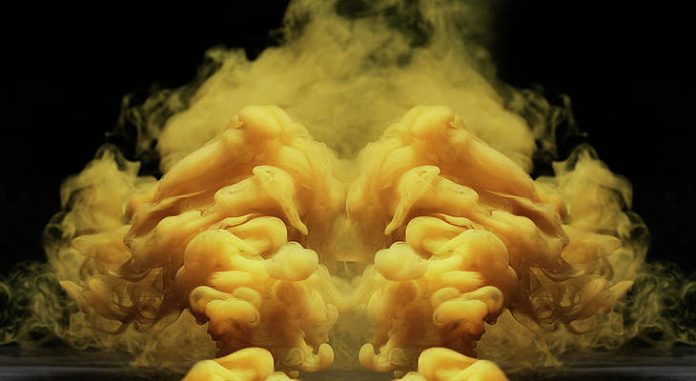Introduction
Understanding of probability is must for a data science professional. Solutions to many data science problems are often probabilistic in nature. Hence, a better understanding of probability will help you understand & implement these algorithms more efficiently.
In this article, I will focus on conditional probability. For beginners in probability, I would strongly recommend that you go through this article before proceeding further.
A predictive model can easily be understood as a statement of conditional probability. For example, the probability of a customer from segment A buying a product of category Z in next 10 days is 0.80. In other words, the probability of a customer buying product from Category Z, given that the customer is from Segment A is 0.80.
In this article, I will walk you through conditional probability in detail. I’ll be using examples & real-life scenarios to help you improve your understanding.
You can also check out our new article on Bayes’ Theorem here. It contains a ton of examples and real-world applications – something every data science professional must be aware of.
Table of contents
- Introduction
- 1. Events – Union, Intersection & Disjoint events
- 2. Independent, Dependent & Exclusive Events
- 3. Conditional Probability
- 4. Bayes Theorem
- 5. Example of Bayes Theorem and Probability trees
- 6. Frequentist vs Bayesian Definitions of probability
- 7. Open Challenges
- Frequently Asked Questions
- End Notes
1. Events – Union, Intersection & Disjoint events
Before we explore conditional probability, let us define some basic common terminologies:
1.1 EVENTS
An event is simply the outcome of a random experiment. Getting a heads when we toss a coin is an event. Getting a 6 when we roll a fair die is an event. We associate probabilities to these events by defining the event and the sample space.
The sample space is nothing but the collection of all possible outcomes of an experiment. This means that if we perform a particular task again and again, all the possible results of the task are listed in the sample space.
For example: A sample space for a single throw of a die will be {1,2,3,4,5,6}. One of these is bound to occur if we throw a die. The sample space exhausts all the possibilities that can happen when that experiment is performed.
An event can also be a combination of different events.
1.2 Union of Events
We can define an event (C) of getting a 4 or 6 when we roll a fair die. Here event C is a union of two events:
Event A = Getting a 4
Event B = Getting a 6
P (C) = P (A ꓴ B)
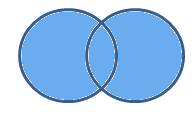
In simple words we can say that we should consider the probability of (A ꓴ B) when we are interested in combined probability of two (or more) events.
1.3. Intersection of Events
Let’s look at another example.
Let C be the event of getting a multiple of 2 and 3 when you throw a fair die.
Event A = Getting a multiple of 2 when you throw a fair die
Event B = Getting a multiple of 3 when you throw a fair die
Event C = Getting a multiple of 2 and 3
Event C is an intersection of event A & B.
Probabilities are then defined as follows.
P (C) = P (A ꓵ B)
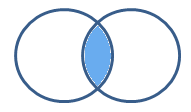
We can now say that the shaded region is the probability of both events A and B occurring together.
1.4 Disjoint Events
What if, you come across a case when any two particular events cannot occur at the same time.
For example: Let’s say you have a fair die and you have only one throw.
Event A = Getting a multiple of 3
Event B = Getting a multiple of 5
You want both event A & B should occur together.
Let’s find the sub space for Event A & B.
Event A = {3,6}
Event B = {5}
Sample Space= {1,2,3,4,5,6}
As you can see, there is no case for which event A & B can occur together. Such events are called disjoint event. To represent this using a Venn diagram:

Now that we are familiar with the terms Union, intersection and disjoint events, we can talk about independence of events.
2. Independent, Dependent & Exclusive Events
Suppose we have two events – event A and event B.
If the occurrence of event A doesn’t affect the occurrence of event B, these events are called independent events.
Let’s see some examples of independent events.
- Getting heads after tossing a coin AND getting a 5 on a throw of a fair die.
- Choosing a marble from a jar AND getting heads after tossing a coin.
- Choosing a 3 card from a deck of cards, replacing it, AND then choosing an ace as the second card.
- Rolling a 4 on a fair die, AND then rolling a 1 on a second roll of the die.
In each of these cases the probability of outcome of the second event is not affected at all by the outcome of the first event.
Probability of independent events
In this case the probability of P (A ꓵ B) = P (A) * P (B)
Let’s take an example here. Suppose we win the game if we pick a red marble from a jar containing 4 red and 3 black marbles and we get heads on the toss of a coin. What is the probability of winning?
Let’s define event A, as getting red marble from the jar
Event B is getting heads on the toss of a coin.
We need to find the probability of both getting a red marble and a heads in a coin toss.
P (A) = 4/7
P (B) = 1/2
We know that there is no affect of the color of the marble on the outcome of the coin toss.
P (A ꓵ B) = P (A) * P (B)
P (A ꓵ B) = (4/7) * (1/2) = (2/7)
Now, it’s time to implement the independent tests in R
Let us consider the following example:
Example:
We have two cards on which numbers are written on both front and back (1 at front and 2 at back). We will toss those two cards in air and see if the results of the two cards are independent. We toss the cards 2000 times, and then compute the joint distribution of the results of the toss from the two cards.
Output
prob_table1 y1 y2 x1 0.2555 0.244 x2 0.2515 0.249 prob_table2 y1 y2 x1 0.2550247 0.2504752 x2 0.2494752 0.2450247
We see that prob_table1 and prob_table2 have close values, indicating that the toss of the two cards are probably independent.
Probability of dependent events
Next, can you think of examples of dependent events ?
In the above example, let’s define event A as getting a Red marble from the jar. We then keep the marble out and then take another marble from the jar.
Will the probabilities in the second case still be the same as that in the first case?
Let’s see. So, for the first time there are 4/7 chances of getting a red marble. Let’s assume you got a red marble on the first attempt. Now, for second chance, to get a red marble we have 3/6 chances.
If we didn’t get a red marble on the first attempt but a white marble instead. Then, there were 4/6 chances to get the red marble second time. Therefore the probability in the second case was dependent on what happened the first time.
Quiz 1: If you have a Jack and your next card is dealt with a new deck of cards the probability of you obtaining a jack again is? Are these events dependent or independent?
Mutually exclusive and Exhaustive events
Mutually exclusive events are those events where two events cannot happen together.
The easiest example to understand this is the toss of a coin. Getting a head and a tail are mutually exclusive because we can either get heads or tails but never both at the same in a single coin toss.
A set of events is collectively exhaustive when the set should contain all the possible outcomes of the experiment. One of the events from the list must occur for sure when the experiment is performed.
For example, in a throw of a die, {1,2,3,4,5,6} is an exhaustive collection because, it encompasses the entire range of the possible outcomes.
Consider the outcomes “even” (2,4 or 6) and “not-6” (1,2,3,4, or 5) in a throw of a fair die. They are collectively exhaustive but not mutually exclusive.
Quiz 2: Check whether the below events are mutually exclusive:
- Drawing a red card or a jack from a given 52 cards deck.
- Getting three heads or three tails when three coins are flipped.
3. Conditional Probability
Conditional probabilities arise naturally in the investigation of experiments where an outcome of a trial may affect the outcomes of the subsequent trials.
We try to calculate the probability of the second event (event B) given that the first event (event A) has already happened. If the probability of the event changes when we take the first event into consideration, we can safely say that the probability of event B is dependent of the occurrence of event A.
Let’s think of cases where this happens:
- Drawing a second ace from a deck given we got the first ace
- Finding the probability of having a disease given you were tested positive
- Finding the probability of liking Harry Potter given we know the person likes fiction
And so on….
Here we can define, 2 events:
- Event A is the probability of the event we’re trying to calculate.
- Event B is the condition that we know or the event that has happened.
We can write the conditional probability as 

Let’s play a simple game of cards for you to understand this. Suppose you draw two cards from a deck and you win if you get a jack followed by an ace (without replacement). What is the probability of winning, given we know that you got a jack in the first turn?
Let event A be getting a jack in the first turn
Let event B be getting an ace in the second turn.
We need to find
P(A) = 4/52
P(B) = 4/51 {no replacement}
P(A and B) = 4/52*4/51= 0.006

Here we are determining the probabilities when we know some conditions instead of calculating random probabilities. Here we knew that he got a jack in the first turn.
Let’s take another example.
Suppose you have a jar containing 6 marbles – 3 black and 3 white. What is the probability of getting a black given the first one was black too.
P (A) = getting a black marble in the first turn
P (B) = getting a black marble in the second turn
P (A) = 3/6
P (B) = 2/5
P (A and B) = ½*2/5 = 1/5

Let us now consider a new example and implement in R.
Example:
A research group collected the yearly data of road accidents with respect to the conditions of
following and not following the traffic rules of an accident prone area. They are interested in calculating the probability of accident given that a person followed the traffic rules. The table of the data is given as follows:
| Condition | Follow Traffic Rule | Does not follow Traffic Rule |
| Accident | 50 | 500 |
| No Accident | 2000 | 5000 |
Now here our equation becomes:
P(Accident | A person follow Traffic Rule) = P(Accident and follow Traffic Rule) / P(Follow Traffic Rule)
Solution:
Output
Conditional_Probability 0.02439024
3.1 Reversing the condition
Example: Rahul’s favorite breakfast is bagels and his favorite lunch is pizza. The probability of Rahul having bagels for breakfast is 0.6. The probability of him having pizza for lunch is 0.5. The probability of him, having a bagel for breakfast given that he eats a pizza for lunch is 0.7.
Let’s define event A as Rahul having a bagel for breakfast, Event B as Rahul having a pizza for lunch.
P (A) = 0.6
P (B) = 0.5

If we look at the numbers, the probability of having a bagel is different than the probability of having a bagel given he has a pizza for lunch. This means that the probability of having a bagel is dependent on having a pizza for lunch.
Now what if we need to know the probability of having a pizza given you had a bagel for breakfast. i.e. we need to know 
4. Bayes Theorem
The Bayes theorem describes the probability of an event based on the prior knowledge of the conditions that might be related to the event. If we know the conditional probability 

How can we do that?


The above statement is the general representation of the Bayes rule.
For the previous example – if we now wish to calculate the probability of having a pizza for lunch provided you had a bagel for breakfast would be = 0.7 * 0.5/0.6.
We can generalize the formula further.
If multiple events Ai form an exhaustive set with another event B.
We can write the equation as

Now, implementing the example in R:
Output
Bayes_Theorem 0.1211449
5. Example of Bayes Theorem and Probability trees
Let’s take the example of the breast cancer patients. The patients were tested thrice before the oncologist concluded that they had cancer. The general belief is that 1.48 out of a 1000 people have breast cancer in the US at that particular time when this test was conducted. The patients were tested over multiple tests. Three sets of test were done and the patient was only diagnosed with cancer if she tested positive in all three of them.
Let’s examine the test in detail.
Sensitivity of the test (93%) – true positive Rate
Specificity of the test (99%) – true negative Rate
Let’s first compute the probability of having cancer given that the patient tested positive in the first test.
P (has cancer | first test +)
P (cancer) = 0.00148
Sensitivity can be denoted as P (+ | cancer) = 0.93
Specificity can be denoted as P (- | no cancer)
Since we do not have any other information, we believe that the patient is a randomly sampled individual. Hence our prior belief is that there is a 0.148% probability of the patient having cancer.
The complement is that there is a 100 – 0.148% chance that the patient does not have CANCER. Similarly we can draw the below tree to denote the probabilities.
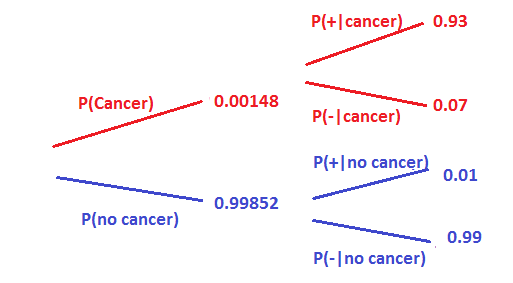
Let’s now try to calculate the probability of having cancer given that he tested positive on the first test i.e. P (cancer|+)

P (cancer and +) = P (cancer) * P (+) = 0.00148*0.93
P (no cancer and +) = P (no cancer) * P(+) = 0.99852*0.01
To calculate the probability of testing positive, the person can have cancer and test positive or he may not have cancer and still test positive.

This means that there is a 12% chance that the patient has cancer given he tested positive in the first test. This is known as the posterior probability.
5.1 Bayes Updating
Let’s now try to calculate the probability of having cancer given the patient tested positive in the second test as well.
Now remember we will only do the second test if she tested positive in the first one. Therefore now the person is no longer a randomly sampled person but a specific case. We know something about her. Hence, the prior probabilities should change. We update the prior probability with the posterior from the previous test.
Nothing would change in the sensitivity and specificity of the test since we’re doing the same test again. Look at the probability tree below.
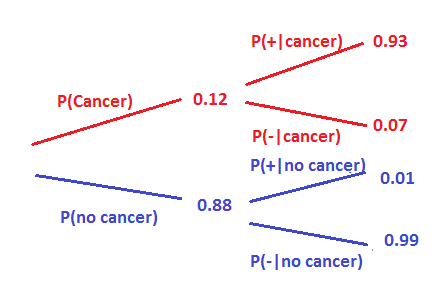
Let’s calculate again the probability of having cancer given she tested positive in the second test.
P (cancer and +) = P(cancer) * P(+) = 0.12 * 0.93
P (no cancer and +) = P (no cancer) * P (+) = 0.88 * 0.01
To calculate the probability of testing positive, the person can have cancer and test positive or she may not have cancer and still test positive.

Now we see, that a patient who tested positive in the test twice, has a 93% chance of having cancer.
6. Frequentist vs Bayesian Definitions of probability
A frequentist defines probability as an expected frequency of occurrence over large number of experiments.
P(event) = n/N, where n is the number of times event A occurs in N opportunities.
The Bayesian view of probability is related to degree of belief. It is a measure of the plausibility of an event given incomplete knowledge.
The frequentist believes that the population mean is real but unknowable and can only be estimated from the data. He knows the distribution of the sample mean and constructs a confidence interval centered at the sample mean. So the actual population mean is either in the confidence interval or not in it.
This is because he believes that the true mean is a single fixed value and does not have a distribution. So the frequentist says that 95% of similar intervals would contain the true mean, if each interval were constructed from a different random sample.
The Bayesian definition has a totally different view point. They use their beliefs to construct probabilities. They believe that certain values are more believable than others based on the data and our prior knowledge.
The Bayesian constructs a credible interval centered near the sample mean and totally affected by the prior beliefs about the mean. The Bayesian can therefore make statements about the population mean by using the probabilities.
7. Open Challenges
- In the cancer example taken above, try calculating the probability of a patient having cancer provided the patient is tested positive in the third test as well.
- In an exam, there is a problem that 60% of students know the correct answer. However, there is 15% chance that a student picked the wrong answer even if he/she knows the right answer And there is also a 25% chance that a student does not know the right answer but guessed it correctly. If a student did get the problem right, what is the chance that this student really knows the answer?
Frequently Asked Questions
A. Conditional probability calculates the likelihood of an event given another event has occurred. Bayes’ Theorem, an extension, incorporates prior probabilities to compute the probability of a cause/event based on the observed effect. It’s used to update beliefs as new information arises. Bayes’ Theorem provides a structured way to adjust probabilities using prior knowledge, making it fundamental in various fields like statistics and machine learning.
A. Bayes’ Theorem is a formula that calculates the probability of an event A occurring given that event B has occurred. It’s expressed as P(A|B) = (P(B|A) * P(A)) / P(B), where P(A) and P(B) are the probabilities of events A and B, and P(B|A) is the probability of event B given event A. It’s a cornerstone of probabilistic reasoning and inference.
End Notes
The debate between Bayesian and frequentist approaches has been going on for a long while. We have an amazing article which has gone deep into both these approaches. It has explained in detail the two approaches and Bayesian Inference.
The aim of this article was to introduce you to conditional probability and Bayes theorem. Bayes theorem forms the backbone of one of very frequently used classification algorithms in data science – Naive Bayes.
Once the above concepts are clear you might be interested to open the doors the naive Bayes algorithm and be stunned by the vast applications of Bayes theorem in it.
Please post your answers to the open challenges in the comments section. And feel free to ask doubts or questions. Hope you enjoyed reading!



